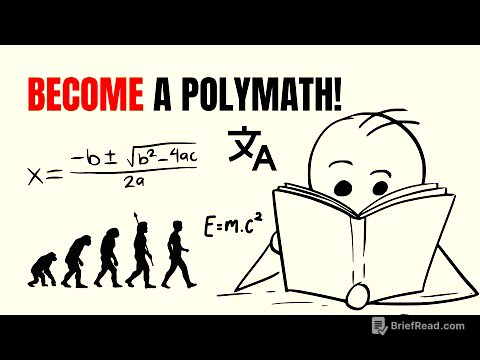TLDR;
This video explains the centrifuge technique, also known as cell fractionation, used in cell biology to separate cell components based on size and density. The procedure involves homogenization to break cells and release organelles, followed by sequential centrifugation at increasing gravity forces to separate components into pellets and supernatants. The video also clarifies the concept of artificial gravity in centrifuge machines and provides a formula to calculate RPM (revolutions per minute) based on gravity and radius.
- Centrifuge technique separates cell components.
- Cell fractionation isolates organelles.
- Homogenization prepares the sample.
- Differential centrifugation separates by size and density.
- Artificial gravity is used in centrifuges.
Introduction to Centrifuge Technique [0:13]
The centrifuge technique, also known as cell fractionation, is a method used in cell biology to separate different components of the cell, such as cell organelles. This technique involves using a centrifuge machine to separate these components. Cell fractionation involves separating parts or components into individual fractions.
Definition of Centrifuge [1:36]
The centrifuge technique is a method used in cell biology and cytology to separate different components of the cell using a centrifuge machine. This separation is based on the size and density of the components. Larger components separate more quickly and settle down, while smaller components take longer to separate.
Procedure: Homogenization [3:48]
The first step in the procedure involves obtaining tissue, which is composed of cells. These cells are attached to each other, so the initial process involves separating the cells and rupturing their membranes to release the cellular components. This is achieved by grinding the tissue in a machine, similar to a juice maker, to create a mixer. This process, called homogenization, results in a mixture containing cells, ruptured cell membranes, and released organelles like mitochondria and chloroplasts. The resulting mixture is called a homogenate. Homogenization is the operation in which cells in the tissue are separated and grinded to get organized.
Centrifugation and Separation [8:34]
The homogenate is placed in test tubes, which are then inserted into a centrifuge machine. The centrifuge machine, powered by electricity, contains a rotor with compartments for the test tubes. The machine is set to specific gravity and time settings. For example, the homogenate might be centrifuged at 800 gravity for 10 minutes. After centrifugation, larger components settle at the bottom, forming a pellet, while the remaining liquid above is called the supernatant. The pellet contains components like nuclei, cells, and cellular debris, which includes organic waste from dead cells.
Sequential Centrifugation [13:21]
To further separate the components, the supernatant from the first centrifugation is transferred to another test tube and centrifuged again at a higher gravity, such as 20,000 gravity for 15 minutes. This process results in another pellet and supernatant. The pellet at this stage typically contains organelles like mitochondria and chloroplasts. The supernatant is then subjected to another round of centrifugation at an even higher gravity, such as 100,000 gravity, to separate smaller components like microsomes, which are small structures of the endoplasmic reticulum.
Artificial Gravity and RPM Calculation [19:02]
The gravity used in centrifuge machines is artificial gravity, generated by the machine itself. Some machines display gravity, while others display RPM (revolutions per minute). RPM refers to the number of revolutions the rotor makes per minute. To calculate RPM from gravity, the formula is: RPM = √(gravity / (1.118 x radius)), where radius is the distance from the center of the rotor to the test tube. This formula allows for the conversion between gravity and RPM settings on the centrifuge machine.









